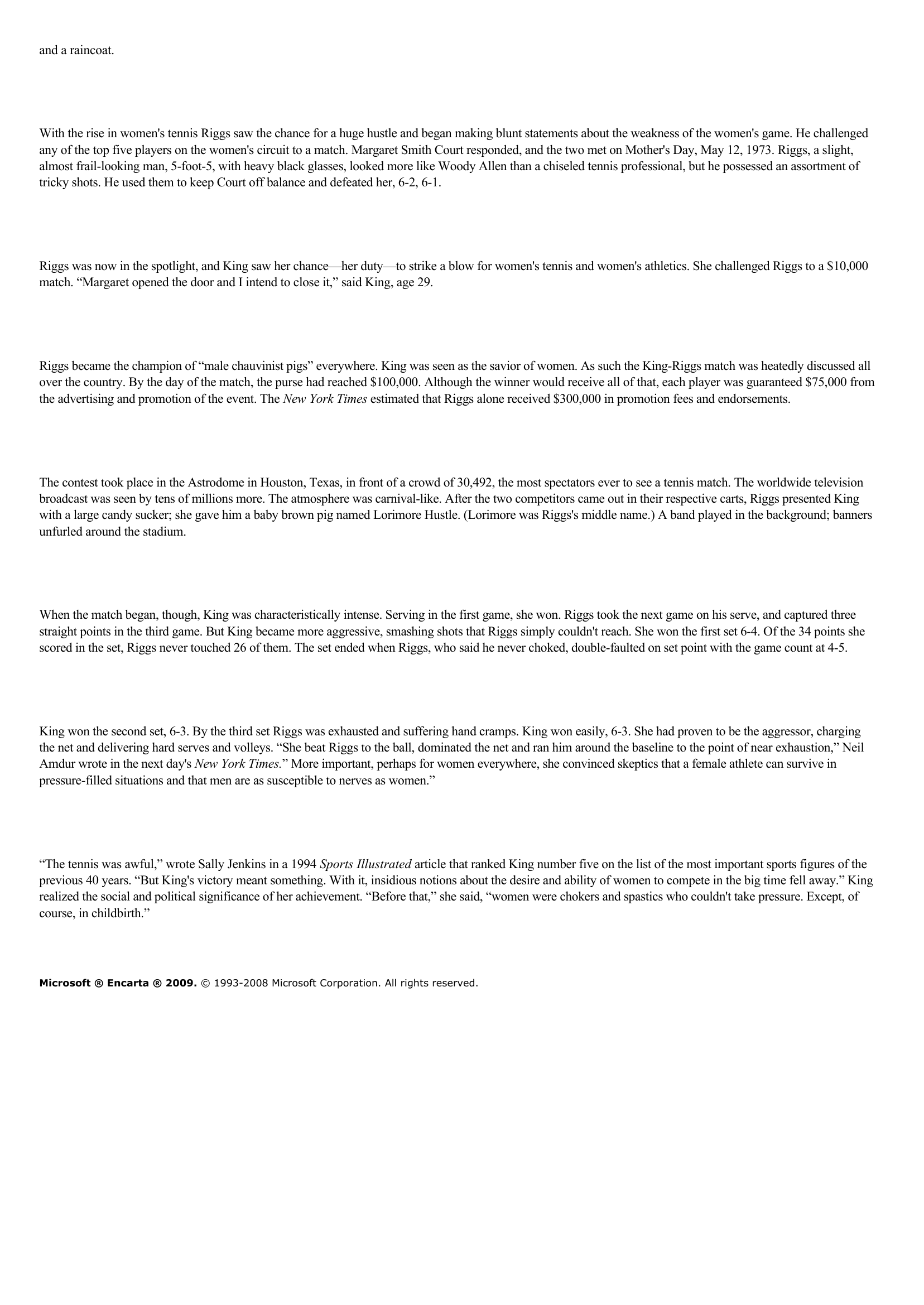The Tennis Battle of the Sexes.
Publié le 14/05/2013

Extrait du document
«
and a raincoat.
With the rise in women's tennis Riggs saw the chance for a huge hustle and began making blunt statements about the weakness of the women's game.
He challengedany of the top five players on the women's circuit to a match.
Margaret Smith Court responded, and the two met on Mother's Day, May 12, 1973.
Riggs, a slight,almost frail-looking man, 5-foot-5, with heavy black glasses, looked more like Woody Allen than a chiseled tennis professional, but he possessed an assortment oftricky shots.
He used them to keep Court off balance and defeated her, 6-2, 6-1.
Riggs was now in the spotlight, and King saw her chance—her duty—to strike a blow for women's tennis and women's athletics.
She challenged Riggs to a $10,000match.
“Margaret opened the door and I intend to close it,” said King, age 29.
Riggs became the champion of “male chauvinist pigs” everywhere.
King was seen as the savior of women.
As such the King-Riggs match was heatedly discussed allover the country.
By the day of the match, the purse had reached $100,000.
Although the winner would receive all of that, each player was guaranteed $75,000 fromthe advertising and promotion of the event.
The New York Times estimated that Riggs alone received $300,000 in promotion fees and endorsements.
The contest took place in the Astrodome in Houston, Texas, in front of a crowd of 30,492, the most spectators ever to see a tennis match.
The worldwide televisionbroadcast was seen by tens of millions more.
The atmosphere was carnival-like.
After the two competitors came out in their respective carts, Riggs presented Kingwith a large candy sucker; she gave him a baby brown pig named Lorimore Hustle.
(Lorimore was Riggs's middle name.) A band played in the background; bannersunfurled around the stadium.
When the match began, though, King was characteristically intense.
Serving in the first game, she won.
Riggs took the next game on his serve, and captured threestraight points in the third game.
But King became more aggressive, smashing shots that Riggs simply couldn't reach.
She won the first set 6-4.
Of the 34 points shescored in the set, Riggs never touched 26 of them.
The set ended when Riggs, who said he never choked, double-faulted on set point with the game count at 4-5.
King won the second set, 6-3.
By the third set Riggs was exhausted and suffering hand cramps.
King won easily, 6-3.
She had proven to be the aggressor, chargingthe net and delivering hard serves and volleys.
“She beat Riggs to the ball, dominated the net and ran him around the baseline to the point of near exhaustion,” NeilAmdur wrote in the next day's New York Times. ” More important, perhaps for women everywhere, she convinced skeptics that a female athlete can survive in pressure-filled situations and that men are as susceptible to nerves as women.”
“The tennis was awful,” wrote Sally Jenkins in a 1994 Sports Illustrated article that ranked King number five on the list of the most important sports figures of the previous 40 years.
“But King's victory meant something.
With it, insidious notions about the desire and ability of women to compete in the big time fell away.” Kingrealized the social and political significance of her achievement.
“Before that,” she said, “women were chokers and spastics who couldn't take pressure.
Except, ofcourse, in childbirth.”
Microsoft ® Encarta ® 2009. © 1993-2008 Microsoft Corporation.
All rights reserved..
»
↓↓↓ APERÇU DU DOCUMENT ↓↓↓
Liens utiles
- BATAILLE DES LIVRES (La) [The Battle of the Books] (résumé & analyse) de Jonathan Swift
- Myrmidons Greek Warlike people of ancient Thessaly, in the eastern part of the Greek mainland, who accompanied the hero Achilles into battle in the Trojan War.
- Palla s (Warrior) Greek A second generation Titan; considered by some to be the god of warfare and of the springtime battle season.
- Enyo (1) Greek A goddess of war, specifically known for sacking cities and towns of the enemy; daughter of Zeus and Hera; depicted as the sister, daughter, or mother of the war god Ares, often included as a companion of Ares when he went into battle.
- Eris (Discord) Greek The spirit or goddess of strife; the sister of Ares, Eris accompanied him into battle and helped to cause quarrels and lawlessness.








